#wooden artifacts
Explore tagged Tumblr posts
Text
Exquisite Wooden Artifacts to Beautify Your Home

Elevate your home decor with exquisite wooden artifacts that stand out in any room. These meticulously crafted pieces celebrate the beauty and versatility of wood, making them the perfect addition to any interior. From finely carved sculptures to functional decor, each artifact is designed to bring natural elegance to your space. Whether you're decorating a modern home or a rustic retreat, these wooden creations add a unique touch that is both timeless and sustainable. Make a statement with these elegant, handcrafted items that reflect a rich artistic tradition and complement your personal style.
#wooden artifacts#wooden handicarfts#wooden items#wooden decor#woodenitems#wooden products#wooden mobile stand
0 notes
Text

Child toy - a warship made of wooden blocks, Germany early 20th century
Photo by me- IMM Hamburg
#naval art#naval history#naval artifacts#child toy#warship#wooden blocks#early 20th century#age of steam
91 notes
·
View notes
Photo

Wooden Sphere
Artist: Mark Tedin TCG Player Link Scryfall Link EDHREC Link
46 notes
·
View notes
Text
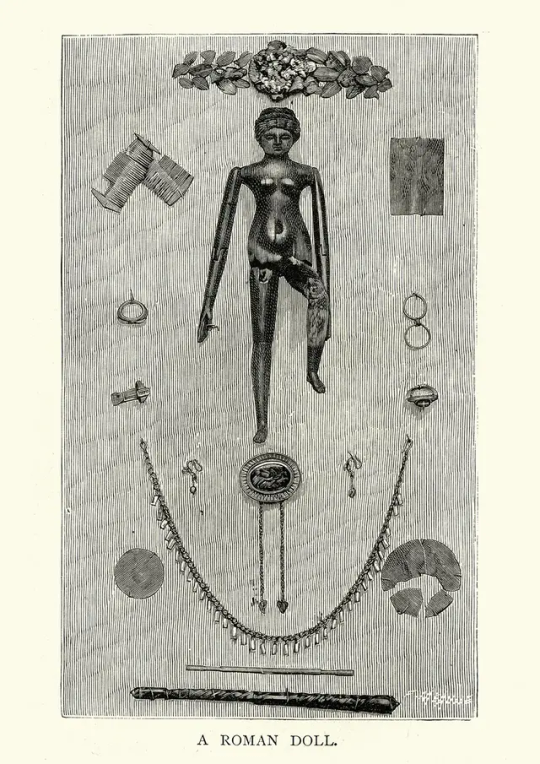

Source identifier: PCM (Hades Legacy Identifier / Struc ID) Content: Printed on border: "The above picture shows a jointed doll and other articles recently found in the sarcophagus of a young lady of ancient Rome, named Crepereia Trifena." Includes additional text.Content: Illegible engraver signature on image.
The Miriam and Ira D. Wallach Division of Art, Prints and Photographs: Picture Collection, The New York Public Library. "A Roman doll" The New York Public Library Digital Collections. 1894. https://digitalcollections.nypl.org/items/510d47e4-37c7-a3d9-e040-e00a18064a99
#Roman Doll#Crepereia Trifena#The New York Public Library#artifacts#ancient artifacts#doll#dolls#ancient#wooden articulated doll#articulated doll#jointed doll
71 notes
·
View notes
Text
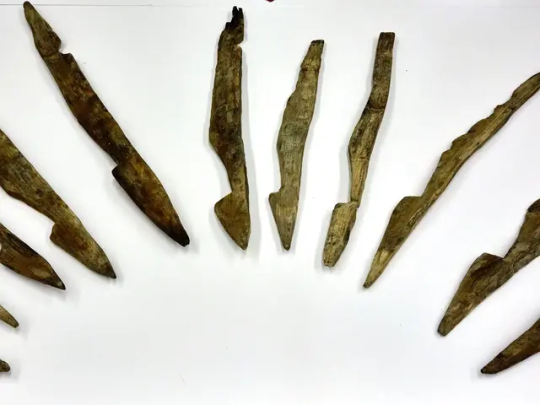
Roman Fort Defended by Wooden Stakes Discovered in Germany
For the first time, archaeologists have discovered well-preserved sharpened wooden stakes used to deter attacks from enemies at an ancient Roman military camp from the first century CE.
Researcher Frederic Auth from Frankfurt’s Goethe University discovered the spikes at an excavation site in the German town of Bad Ems.
Installations of these martial-looking wooden structures, comparable to modern barbed wire and metal bird spikes, have been referenced in literature and by Julius Caesar. But prior to Auth’s discovery, none had been found.
Experts believe the military had a presence at the site specifically because of the Romans’ investment in the lucrative precious metal mining operation there, which would need defense against sudden raids for the valuable raw material. But Goethe University archaeology professor Markus Scholz said further research is necessary to verify this theory.
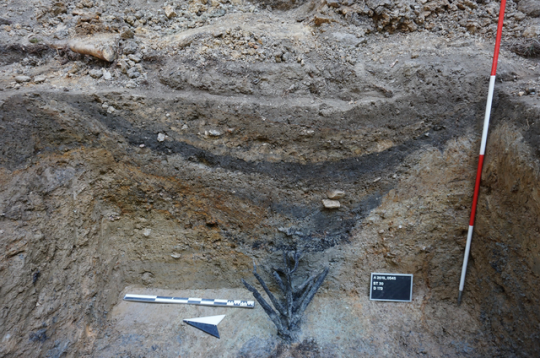
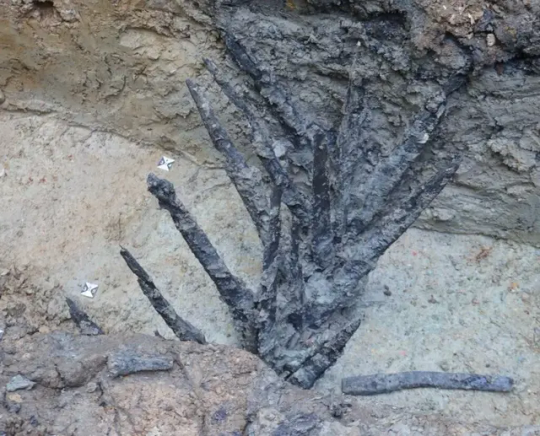
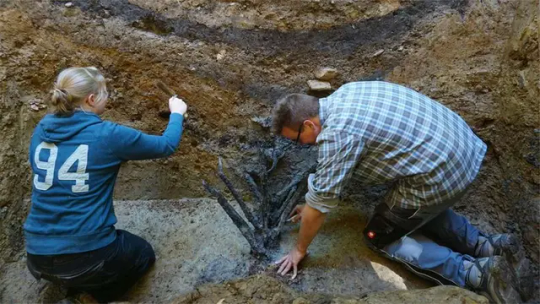
The university’s archaeology department has been overseeing a multiyear excavation project in the area focused on the Roman search for silver ore in the 1st century CE and the establishment of two military camps.
A hunter’s observations of color differences in a grain field, a sign of subsurface structures, triggered the excavations in 2016. A drone photo found a track crisscrossing the field that was actually a double ditch, framing a Roman camp. The spikes were preserved through the area’s damp soil.
According to a statement from the university, geomagnetic prospecting later revealed a 20-acre military camp with about 40 wooden towers.
Auth also led a student team to discover a smaller military camp made of wood that held approximately 40 men, located two kilometers away.
Notably, the spiked wooden defense structure was discovered on the second-last day of the team’s excavations, along with a coin minted in 43 CE. The coin was proof that the military structure could not have been built in connection with ancient Roman fortifications known as the Limes, which were built around 110 CE.
By Karen K. Ho.
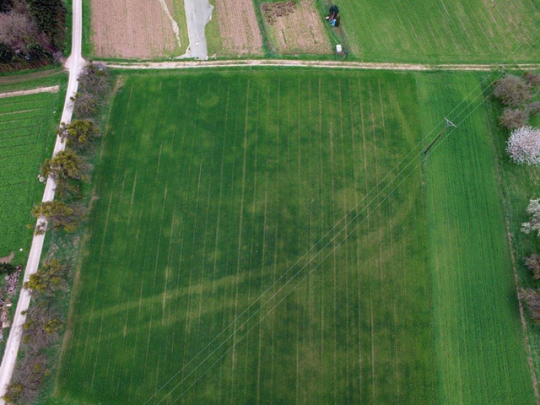
#Roman Fort Defended by Wooden Stakes Discovered in Germany#Bad Ems#ancient artifacts#archeology#archeolgst#history#history news#ancient history#ancient culture#ancient civilizations#roman history#roman empire
43 notes
·
View notes
Text


Pa's Display
#photography#aesthetic#wooden#ornament#interior decor#antique#brown#wood#woodwork#artifacts#trinkets#decoration#shrine
3 notes
·
View notes
Text

Ijo forest spirit, Nigeria.
3 notes
·
View notes
Text
Day 29: Guatemalan Wooden Masks: Tradition, Craftsmanship, and Cultural Inspiration
— Introduction Guatemalan wooden masks are vibrant artifacts that embody the culture, history, and artistic expression of the country’s diverse ethnic groups. Rooted in centuries-old traditions, these masks have served many purposes in religious rituals, celebrations, and storytelling, providing an intimate glimpse into the cultural identity of Guatemala. Whether used in traditional dances or…
#Architexture#article#Artisan Craft#Authentic Guatemalan Art#Colorful Masks#Craftsmanship#Cultural Inspiration#Cultural Masks#Decorative Masks#Festival Masks#Guatemala Handicrafts#Guatemalan#Guatemalan Artifacts#Guatemalan Culture#Guatemalan Folk Art#Guatemalan Heritage#Guatemalan Masks#Guatemalan Wooden Masks: Tradition#Handmade Masks#History#Indigenous Art#Latin American Crafts#Mayan Masks#Photography#tradition#Traditional Masks#Tribal Masks#Wooden Handicrafts#Wooden Masks
2 notes
·
View notes
Text
476,000 years ago
"To date these objects, the researchers analyzed minerals in the sand that surrounded them through a technique called luminescence dating, Geoff Duller, a co-author of the study and dating expert at Aberystwyth University in Wales, tells the AP. The smaller wooden objects were buried around 390,000 and 324,000 years ago."
There are good pics and diagrams of the finds in this Nature article. Found tools - flake tools, cleavers, handaxes and core axes - and the wooden structure. "This construction has no known parallels in the African or Eurasian Palaeolithic."
"...before this new find, the oldest known structure made of wood was only 9,000 years old.." Smithsonian
#archeology#Kalambo Falls#zambia#wooden artifacts#hand tools#oldest human building#2019#early stone age
3 notes
·
View notes
Text
Shona Wooden Headrest
A carved wooden headrest of the Shona tribe. The Shona created such southern African kingdoms as Great Zimbabwe and Mutapa between the 12th and 17th century CE. Zimbabwe, 19th century CE. Shona sculptors have invested the southern African tradition of carved wooden headrests with an unparalleled degree of formal interpretation. This headrest is typical of the approach of Shona sculptors from the…

View On WordPress
#African artifact#African History#shona history#shona people#Shona Wooden Headrest#South Africa history#South African artifacts
4 notes
·
View notes
Text
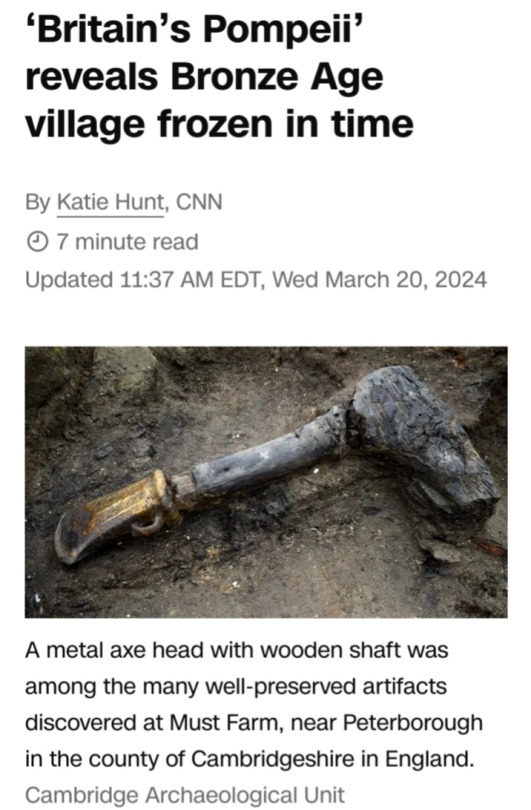
(CNN) — It’s late summer 2,850 years ago. A fire engulfs a stilt village perched above a boggy, slow-moving river that weaves though the wetlands of eastern England.
The tightly packed roundhouses, built from wood, straw, turf, and clay just nine months earlier, go up in flames.
The inhabitants flee, leaving behind all their belongings, including a wooden spoon in a bowl of half-eaten porridge.
There is no time to rescue the fattened lambs, which are trapped and burnt alive.
The scene is a vivid and poignant snapshot, captured by archaeologists, of a once thriving community in late Bronze Age Britain known as Must Farm, near what’s now the town of Peterborough.
The research team published a two-volume monograph on Wednesday that describes their painstaking $1.4 million (£1.1 million) excavation and analysis of the site in the county of Cambridgeshire.
Described by the experts involved as an “archaeological nirvana,” the site is the only one in Britain that lives up to the “Pompeii premise,” they say, referencing the city forever frozen in time by the eruption of Mount Vesuvius in AD 79 that has yielded unparalleled information about ancient Rome.
“In a typical Bronze Age site, if you’ve got a house, you’ve probably got maybe a dozen post holes in the ground and they’re just dark shadows of where it once stood.
If you’re really lucky, you’ll get a couple of shards of pottery, maybe a pit with a bunch of animal bones.
This was the complete opposite of that process. It was just incredible,” said Chris Wakefield of the Cambridge Archaeological Unit at the University of Cambridge, an archaeologist and member of the 55-person team that excavated the site in 2016.
"All the axe marks had been used to shape and sculpt the wood. All of those looked fresh, like they could have been done last week by someone,” Wakefield added.
The remarkably preserved condition of the site and its contents enabled the archaeological team to draw comprehensive new insights into Bronze Age society — findings that could overturn the current understanding of what everyday life was like in Britain during the ninth century BC.
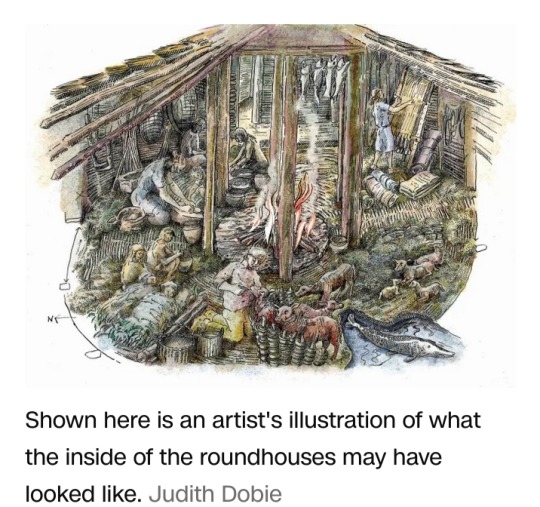
Must Farm domesticity — and a mystery
The site, which dates to eight centuries before Romans arrived in Britain, revealed four roundhouses and a square entranceway structure, which stood approximately 6.5 feet (2 meters) above the riverbed and were surrounded by a 6.5-foot (2-meter) fence of sharpened posts.
The archaeologists believe the settlement was likely twice as big. However, quarrying in the 20th century destroyed any other remains.
Though charred from the fire, the remaining buildings and their contents were extremely well preserved by the oxygen-starved conditions of the fens, or wetlands, and included many wooden and textile items that rarely survive in the archaeological record.
Together, traces of the settlement paint a picture of cozy domesticity and relative plenty.
The researchers unearthed 128 ceramic artifacts — jars, bowls, cups and cookware — and were able to deduce that 64 pots were in use at the time of fire.
The team found some stored pots neatly nested.

Textiles found at the site made from flax linen had a soft, velvety feel with neat seams and hems, although it wasn’t possible to identify individual pieces of clothing.
Wooden artifacts included boxes and bowls carved from willow, alder and maple, 40 bobbins, many with threads still attached, various tools, and 15 wooden buckets.
“One of those buckets … on the bottom of it were loads and loads of cut marks, so we know that people living in that Bronze Age kitchen when they needed an impromptu chopping board, were just flipping that bucket upside down and using that as a chopping surface,” Wakefield said.
“It’s those little moments that build together to give a richer, fuller picture of what was going on.”

The circumstances of the event that brought it all to a halt are still a bit of a mystery.
The researchers believe the fire took place in late summer or early autumn because skeletal remains of the lambs kept by one household showed the animals, typically born in spring, were three months to six months old.
However, what exactly caused the devastating fire remains unclear. The blaze could have been accidental or deliberately started.
The researchers uncovered a stack of spears with shafts over 10 feet (3 meters) long at the site, and many experts think that warfare was common in the time period.
The team worked with a forensic fire investigator but ultimately couldn’t identify a specific “smoking gun” clue pointing to the cause.
“An archaeological site is a lot like a jigsaw puzzle. At a typical site you have 10 or 20 pieces out of 500,” Wakefield said.
“Here, we had 250 or 300 pieces and we still couldn’t get the complete picture on how this big fire broke out.”
Mike Parker Pearson, a professor of British later prehistory at the Institute of Archaeology at University College London, described both the report and the site “as exceptional.” He wasn’t involved in the research.
“The fire may have been disastrous for the inhabitants but it is a blessing for archaeologists, a unique snapshot of life in the Bronze Age,” he said via email.
Upending ideas about Bronze Age society
The contents across the four preserved houses were “remarkably consistent."
Each one had a tool kit that included sickles, axes, gouges, and handheld razors used to cut hair or cloth.
With almost 538 square feet (50 square meters) of floor space in the largest, each of the dwellings appeared to have distinct activity zones comparable to rooms in a modern home.
“By plotting the positions of all these finds — pots, loomweights, tools, and even sheep droppings, the archaeological team have reconstructed the houses’ internal use of space,” Parker Pearson noted.
“The kitchen area was in the east, the storage and weaving area in the south and southeast with the penning area for lambs, and the sleeping area in the northwest, though we don’t know where the doorway was for each house.”
Not all the items were of practical use, such as 49 glass beads plus others made of amber.
Archaeologists also unearthed a woman’s skull, smooth from touch, possibly a keepsake of a lost loved one.
Some of the items the researchers found will go on display starting April 27 in an exhibition titled “Introducing Must Farm: A Bronze Age Settlement” at the Peterborough Museum and Art Gallery.
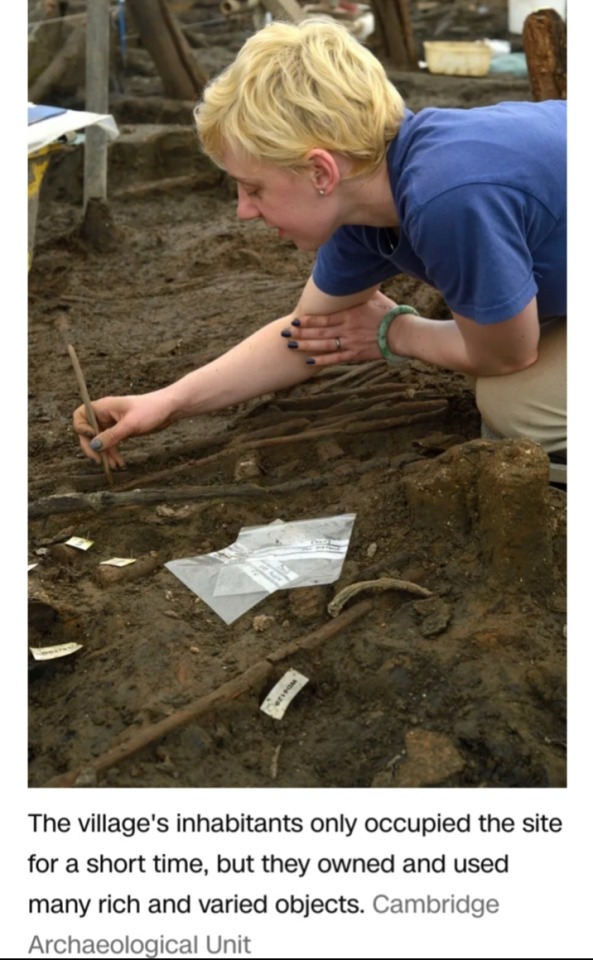
Lab analysis of biological remains revealed the types of food the community once consumed.
A pottery bowl imprinted with the finger marks of its maker held a final meal — a wheat grain porridge mixed with animal fat.
Chemical analyses of the bowls and jars showed traces of honey along with deer, suggesting the people who used the dishes might have enjoyed honey-glazed venison.
Ancient excrement found in waste piles below where the houses would have stood showed that the community kept dogs that fed on scraps from their owners’ meals.
And human fossilized poop, or coprolites, showed that at least some inhabitants suffered from intestinal worms.
The waste piles, or middens, were one line of evidence that showed how long the site was occupied, with a thin layer of refuse suggesting the settlement was built nine months to a year before it went up in flames.
"Two other factors supported that line of reasoning," Wakefield said.
“The second was that a lot of the wood that was used in the construction was unseasoned, it was still effectively green, it hadn’t been long in position,” he said.
“The third one is that we have a lack of the kind of insects and animals that are associated with human habitation."
"It wouldn’t be long before beetles would worm (in) … but there’s no evidence of any of that in any of the 18,000 plus timbers.”
The fact that the site, with its rich and varied contents, was in use for only a year upended the team’s preconceived “visions of everyday life” in the ninth century BC.
It may suggest that Bronze Age societies were perhaps less hierarchical than traditionally thought, according to the 1,608-page report.
“We are seeing here not the accumulation of a lifetime, but just a year’s worth of materials,” the authors noted in the report.
“It suggests that artefacts such as bronze tools and glass beads were more common than we often imagine and that their availability may not in fact have been restricted.”
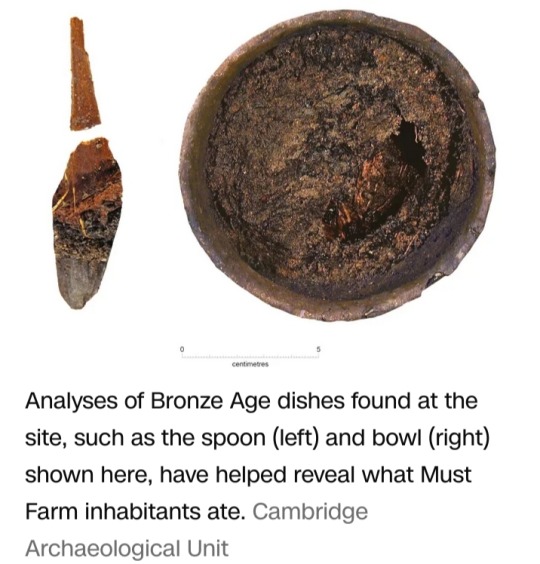
#Must Farm#Late Bronze Age#Late Bronze Age Britain#Cambridgeshire#Peterborough#archaeological nirvana#Pompeii premise#Mount Vesuvius#AD 79#Bronze Age#Chris Wakefield#Cambridge Archaeological Unit#University of Cambridge#9th century BC#Britain's Pompeii#archaeology#archaeologists#ceramic artifacts#wooden artifacts#forensic fire investigator#archaeological site#Institute of Archaeology#University College London#Peterborough Museum and Art Gallery#artefacts#Mike Parker Pearson#history
5 notes
·
View notes
Text

Four unknown wooden ship wrecks at Whiteabbey Bay, Northern Ireland at low tide
#naval artifacts#naval history#wooden shipwrecks#maybe 19th -early 20th century#age of sail#age of steam
115 notes
·
View notes
Photo

Wooden Sphere
Artist: Mark Tedin TCG Player Link Scryfall Link EDHREC Link
28 notes
·
View notes
Text
Designing a Cozy Reading Nook with Old-World Vintage Charm
In a world that moves at lightning speed, finding a quiet space to unwind has become more of a necessity than a luxury. There’s nothing quite like retreating to a cozy reading nook, where the timeless elegance of antique furniture surrounds you, evoking the romance of eras gone by. This article takes you on a journey to design the perfect reading sanctuary, infused with the warmth and character…
#accent furniture#antique armoires#Antique Armories#antique credenza#antique door#Antique Doors#antique doors and arches#antique furniture#Antique Furniture From India#Antique furniture Online#Antique furnitures#antique indian doors#Antique Indian Furniture#antique rustic armoires#antique tribal damchias#antique wardrobe armoire#antique wooden furniture#Antiques#Antiques From India#Antiques Indian Furniture#arches#architectural antiques#authentic Indian artifacts and antiques#barn doors#barndoors#Bold Accent Furniture#carved architectural Doors#carved barn doors#carved door#carved doors
0 notes
Photo



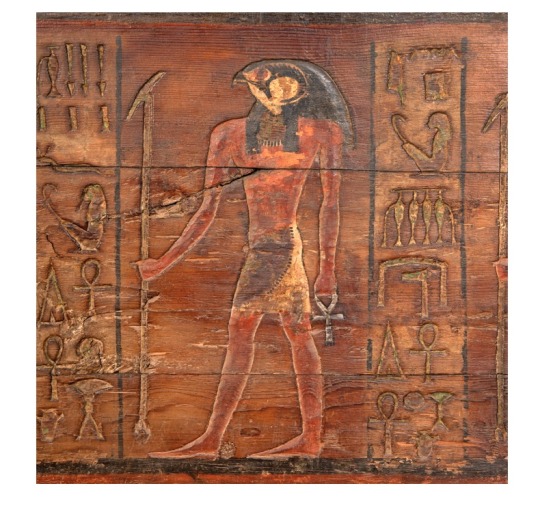
AN EGYPTIAN POLYCHROME WOOD COFFIN PANEL
LATE PERIOD, 26TH DYNASTY, CIRCA 664-525 B.C.
80 1/4 in. x 17 1/4 in. (204 cm. x 44 cm.).
From the side of a wooden coffin, carved in sunken relief with eight standing deities facing left, wearing a short kilt and holding the was sceptre and the ankh symbol. Each figure is flanked by a column of text, identifying the deceased and each god, from left to righ: 'Shu'; 'Imsety, who gives life (to) P(a)wahibreemakhet', 'Anubis, who is upon his hill (?), Great God, Lord of the Sacred Land (cemetery)', 'Hapy, who gives life (to) P(a)ankhwahibre Wahibreemakhet', 'Osiris, who gives life (to) Ankhpawahibre Wahibreemakhet', 'Kebeh-senuef, who gives life (to) Ankhwahibre', 'Anubis, who is foremost in the God’s Booth, who gives life to Wahibreankh (or Ankhwahibre?)', and 'Isis, who gives life to Wahibreankh (or Ankjhwahibre?) Pawahibreemakhet'.
#AN EGYPTIAN POLYCHROME WOOD COFFIN PANEL#LATE PERIOD 26TH DYNASTY CIRCA 664-525 B.C.#ancient wooden coffin#ancient artifacts#archeology#archeolgst#history#history news#ancient history#ancient culture#ancient civilizations#ancient egypt#egyptian history#egyptian hieroglyphs
286 notes
·
View notes
Text
Bringing Timeless Artistry to Modern Life with The Bombay Store's Graphic Works

In a world where modern life constantly pushes us forward, there’s immense joy in carrying a piece of history with us. At The Bombay Store, we believe that tradition shouldn’t be confined to history books or museums. Instead, it can enrich our daily lives, from the coffee we sip to the umbrellas we carry. Every piece at The Bombay Store reflects a seamless blend of heritage and modern design, making it a timeless addition to any lifestyle.
Cherishing Tradition in Everyday Life
Our products help create meaningful connections to the past. From your home to your workspace, each item tells a story of heritage, with intricate designs and handcraftsmanship bringing a touch of history into your daily routine.
Art on Your Table
Tableware at The Bombay Store is more than functional—it’s a showcase of Indian artistry. Coasters, trays, and signature napkin holders adorned with King Procession, Kalamkari, and Mandala motifs turn every meal into a cultural experience, adding elegance to your dining space.
Sip with a Story
Whether you're enjoying tea in a Kullad or coffee mug featuring India Gate or Char Minar, our drinkware celebrates India's rich art forms. Shot glasses with Madhubani and Blue Pottery designs bring stories of India’s artistic legacy into your daily moments.
A Blend of Style and Heritage
Our bags combine practical style with cultural pride. Featuring patterns like Ajrakh, Pattachitra, and Kalamkari, each sling, tote, or laptop bag carries a piece of tradition into your modern lifestyle, bridging the past and the present beautifully.
Pages of Tradition
In an increasingly digital world, our handcrafted diaries offer a refreshing touch of tradition. Leather-bound and adorned with designs like Madhubani, Old Bombay, and Elephant motifs, these diaries serve as both writing tools and artistic keepsakes.
Comfort with Culture
Our cushion covers 16 in x 16 in, add both comfort and character to any space. With designs like Ajrakh, Madhubani, and Bani Thani, they infuse your living room with India’s artistic heritage while offering everyday comfort.
Tradition on the Go
Even the humble umbrella becomes an artistic statement at The Bombay Store. With digitally printed designs like Ajrakh Indigo and Madhubani, our digital-printed umbrellas offer more than protection, they carry a piece of India’s rich art wherever you go.
A Legacy of Tradition and Craftsmanship
For over 100 years, The Bombay Store has celebrated India’s artistic heritage, supporting artisans who keep these traditions alive. Each product is a testament to their skill, ensuring that centuries-old crafts are preserved in modern life.
By choosing The Bombay Store, you're not just purchasing a product, you’re supporting the artisans and keeping India’s cultural traditions alive. In a world of mass production, we offer individuality and artistry, bringing a piece of history into your everyday life. At The Bombay Store, every item has a story, and we invite you to make it part of yours. To know more visit https://thebombaystore.com/
#Online Handicrafts Shop#Home Decore Items#Handicraft Gifts Items#Wall decor item#Decorative gift items#Artifacts home decore#Buy handicrafts online#Wooden decorative items#brass bookmarks
1 note
·
View note